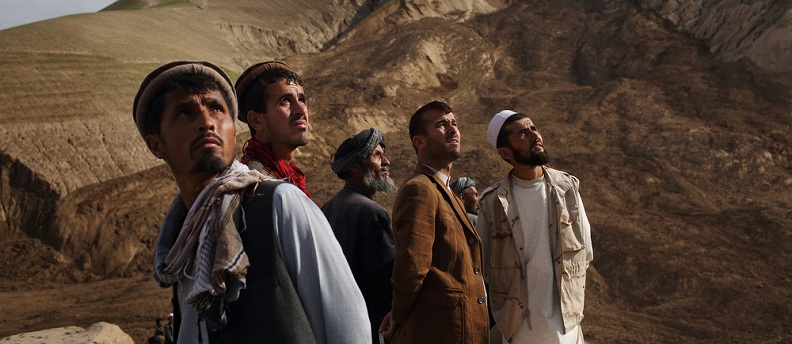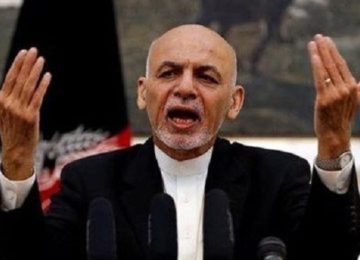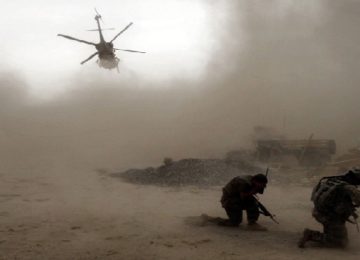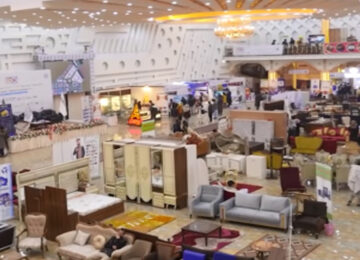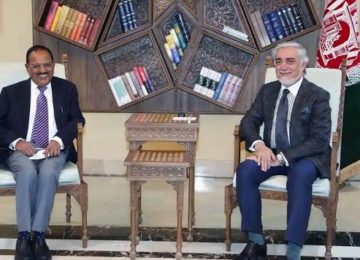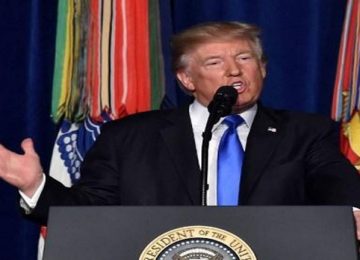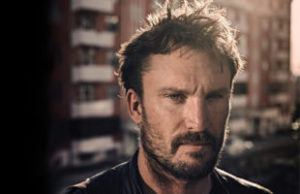
Afghanistan has been an inspiration for many photographers, but very few opt to base themselves in a war-torn country. Andrew Quilty, an Australian photojournalist, is an exception: he came to Afghanistan in 2013 and has been based in Kabul since. Many remember his haunting photographs taken in the ruins of the Kunduz hospital, a week after the US bombed it, for which he won a George Polk Award in 2016. He was also awarded the Gold Walkley, the highest honour in Australian journalism, the same year. His recent exhibition in the Australian embassy in Kabul left many Kabulis impressed. AAN’s Jelena Bjelica asked him to choose five photographs from his Afghanistan portfolio and tell their stories, as well as what it is like to be a photographer in Afghanistan today.
Andrew Quilty started his career at the Australian Financial Review in the early 2000s. Although his early personal photographic work in Australia brought him two awards in 2008, the World Press Photo Award and the Walkley Award for Young Australian Photojournalist of the Year, he was just beginning the successful career of an oft-awarded photographer. (Quilty was awarded the 2014 Nikon Walkley Photographer of the Year and 2015 Walkley Australian Freelance Journalist of the Year. In 2016 he won a George Polk Award and the Gold Walkley, the highest honour in Australian journalism.)
Before he settled in Kabul, he lived and worked in New York City for a year and a half; and after his first visit to Afghanistan – this “formative experience,” as he refers to it – compelled him to move to Kabul where he has been based since December 2013. He has since travelled to more than 20 provinces across Afghanistan and has produced an exquisite body of photographic work that has been published by leading international publications, such as The New York Times, Time Magazine, Harper’s, Mother Jones, The Washington Post, The Wall Street Journal, The Guardian, Le Monde, GEO, Bloomberg Businessweek, The Sydney Morning Herald, The Australian Magazine and many more. In 2016, a selection of Quilty’s work from Afghanistan, After Enduring Freedom, was exhibited at the world’s premier festival for photojournalism, Visa Pour L’Image, in Perpignan, France. (An AAN colleague saw Quilty exhibition in Sarajevo at the Warm Festival in 2016 and wrote about it here).
On AAN’s request, Quilty chose five photographs from his Afghanistan portfolio that have some deeper meaning to him as a photographer. Below are the photos and their stories, as well as Quilty’s reflections on Afghanistan’s light, a photograph’s aesthetics and ethics, security limitations and how to overcome those and other such photojournalistic predicaments.
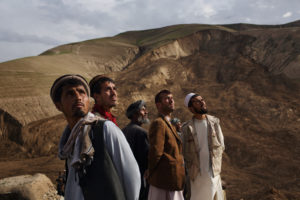
I was at a small social gathering at The New York Times’ bureau in Kabul with others from the foreign press corps when the news of this landslide started filtering in. As As a freelancer myself, I immediately began chasing a commission, and the first outlet I reached out to, TIME Magazine, agreed to put me on. I enlisted the help of a local fixer, Mansour, who arranged what he thought was access to an Afghan military aircraft flying to Badakhshan the following morning. When we arrived at the entrance to the military section of K abul International Airport (KAIA), however, our names were on only one of several lists that had been made by a variety of government officials. The flight appeared to be at least quadruple-booked.
There must have been ten checkpoints that Mansour and I had to talk our way through before we even made it to the tarmac, where government officials, ministers, and a vice president were all trying to board this Afghan Air Force C-130 Hercules.
As for media, whoever was in control of the flight, for some reason, decided they were only going to let the BBC and the Guardian aboard. I was one of dozens of other journalists – both Afghan and foreign – who looked like we were going to be left behind.
I was new in Kabul back in 2014, and as blatantly ambitious as it sounds, this was a big opportunity for me. I was adamant that I was going to get on the plane. Mansour and I managed to make it to a pack of maybe 100 people pushing and shoving at the back of the plane when, all of a sudden, the rear cargo door started rising off the ground. I got one foot up and felt Mansour push me from behind as the door continued to close. I literally crawled through the legs of one soldier and past others, found a seat, put a scarf over my head, and pretended I was sleeping. Mansour didn’t make it onto the plane.
When we landed in Faizabad, I had no idea where I was, but with help from fellow journalist colleagues I made it to the site.
I took this photograph soon after I arrived at the site. The men in the photo, with the landslide behind them, were looking up at the helicopter flying out with Vice President Khalili, who had been on the plane I came up with and then flown to and from the site from Faizabad.
I used the helicopter flying by as a distraction. Without having time to spend with those you’re photographing – as is often the case in Afghanistan – it is almost impossible for people to get used to a photographer’s presence and not react when you lift the camera. At home, in Australia, I could spend days with people I would photograph, and after a while they would go about their business, not oblivious but at least less conscious of my presence.
In this instance with the helicopter, when you’ve been taking pictures for long enough you begin to look for and anticipate these kind of moments and the opportunities they provide. You know that when the helicopter flies by everyone will look at it, so you see it coming, position yourself and wait for the split second where it all falls into place in the viewfinder, achieving, most importantly in this instance, a sense of spontaneity in the photograph that was not achievable either seconds prior or after. On top of that is the added symbolism of the divide between the haves-and-have-not in Afghanistan: the civilians watching the departing government official after his photo-op at the site of their disaster, their reality.
I learned a lot during that trip to Badakhshan about the restrictions of working in Afghanistan – especially in the provinces – like which times of day are safer to work and when and where not to be on the road. The general thinking is that it is safer to be out in the middle of the day, which of course is the worst time of day for a photographer.
The landslide in Argo was one of those unusual situations when attention is drawn to on one area of the country: a high concentration of security forces, aid workers, VIPs, and media, all focused on one area. On the one hand, there is strength in numbers, but on the other hand, opportunists who know that outsiders are on the road try to take advantage.
Nevertheless, as a photographer in Afghanistan, you take advantage of the opportunities and the access that opens up when security is heightened.
Working in Afghanistan forced me to focus more on the subject than on aesthetics and graphic elements. Back in Australia, when I was learning the ropes, I had become very selective with light, mostly because of the photographers that I admired. I like to shoot early and late in the day and find it hard to be enthusiastic about working anytime in between.
The security situation here – primarily the risk that comes with public exposure – also changes the way I work. It forces me to work quickly, under circumstances I might not choose if I had a choice, particularly when it comes to time of day and location.
I do not think of myself as a huge risk taker. A lot of planning goes into travel outside Kabul: we do not just jump in a taxi and head for the hills. I was inexperienced and a bit ignorant in Badakhshan, and probably pushed my luck more than I would these days. Now, working with colleagues, I’m often the one who questions going here or there and often I’ll be the one telling journalists to wrap up their interviews because it feels like we have been in one place too long; but at the same time, I think I have a better sense of what is reasonable risk than someone sitting behind the desk in New York, or London, or even Kabul. It is something you can only learn from experience, and I trust my instincts and those of most of my colleagues on that.
(For more on the Badakhshan landslides, see AAN’s previous reporting here and on the impact of climate change in Afghanistan see AAN’s analysis here).
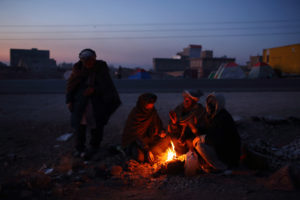
This was taken on my first trip to Herat province. I was new to the country, new to the circumstances, new to the poverty.
The friend and colleague I had come to Afghanistan with were driving around the edge of the city and came across these large groups of people who seemed to be camped by the side of the road. They were internally displaced persons (IDPs) from Ghor province.
It was freezing cold. Some families had tents while others made shelters out of cinder blocks and tarpaulins. People were sleeping under piles of cheap, heavy Chinese blankets that locals had donated. Each afternoon, businessmen would bring them by the carload, as well as food, fire wood, tents and other basics.
I found the scene very confronting – these little kids on the side of the road crying from the cold. I remember thinking – as most people probably do when they’re first confronted by such misery – that we had to do something to help. We went into the city and found a guy selling winter gloves on a pushcart. I bought 20 pairs, took them back to the makeshift camp, and was immediately swarmed. They were gone in seconds. When I look back on it now my impulse was kind of analogous to the Western belief that we can come in and, overnight, make a difference and save Afghanistan. That’s not to say that I regret it or anything, but after three or four years here now, I see the futility in the short-term solutions that much of the development and aid industry provides.
I went back early the next morning; I wanted to be there when they woke up.
Well before sunrise, a group of men were already up, squatting around a small fire. They were burning anything they could find – plastic, even scraps of discarded clothing – to keep themselves warm before the sun came up. It was still freezing cold. So cold that, not wearing gloves myself, and trying to keep my hands warm in my pockets, I sliced my palm open on a pocketknife blade that had opened without my realisation until I felt my hand sticking to the camera because it was dripping with blood. These people were there, night after night, while I got back in a heated car, headed for a pharmacy and then back to a hotel.
In a way, it was this trip that made me want to stay in Afghanistan; it helped me find a meaning in photography I hadn’t felt before. I came to Afghanistan from Sydney, where I photographed for a national financial newspaper, mostly taking portraits of fat, rich businessmen.
After I came here and saw real life and the struggle – all these eye-rolling clichés – the idea of going back to a massive metropolis and photographing the latest restaurant to open in the hip part of town, or businessmen, just was not appealing anymore. Now, I feel like my career only really began when I arrived in Afghanistan.
Afghanistan is incredibly photogenic: the light is very different than that which shaped my photography – my photographic style – previously. Australia’s light is harsh and bright and saturated with colour. Here the light is a lot softer, paler; there’s dust, pollution and smoke between the camera and the sun. I think that also helped my photography because I stopped looking for the nice light I had always relied upon, to an extent, elsewhere. In Afghanistan, the stories behind the photographs were so compelling that I wasn’t as dependent on light as I had been.
I think every editorial photographer at one time or another wonders whether he or she could work in a conflict zone, and that was undoubtedly part of the reason I came here, initially – to test myself. But I think I liked working here before I had nailed down whether or not I actually could.
Professionally speaking, it was fortuitous that I came at a time when many photographers had left – there was space for me to find a slice of the market. Also, that somewhat self-righteous notion – that many who become attached to the country feel – of Afghanistan as ‘the forgotten war,’ may have played into my reasoning for staying.
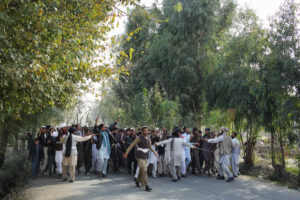
I was on an assignment with the Washington Post. The Khost Protection Force (KPF) is funded and trained by the CIA and is similarly secretive. It is successful – in a General Raziq kind of way (1) – in maintaining a measure of security but attracts plenty of accusations of human rights abuses. I travelled to Khost with the Post’s Kabul correspondent, Sudarsan Raghavan, and one of their national reporters, Sharif Hassan.
While we were there, the KPF conducted a raid in a village ten kilometres outside the city, killing two men that villagers claimed were non-combatant civilians. We were sitting in the dining room of the governor’s compound when one of his staff mentioned what had happened overnight and said that there would be a demonstration in the city. It’s rare that something so pertinent to the story you’re working on – especially in Afghanistan and especially for a story that few want to be photographed or interviewed on-the-record for – lands in your lap like this.
We decided to try to meet the procession that we were told was moving from the village toward the city. Demonstrators were carrying the bodies of the two villagers who had been killed the night before and were marching for the governor’s compound. We drove to a road that we knew they would have to pass. Assuming the procession would be charged with anger from the deaths, we stopped close to a checkpoint that was being manned, coincidentally, by KPF soldiers. Although they are known to be aggressive and heavy-handed, they also have a reputation for being well-trained and disciplined, so we hedged our bets that outside the city we would be safer near them than we would be in a more isolated spot.
We stopped a couple of hundred metres away and watched the demonstrators coming towards us. It all happened very quickly. They were getting closer and closer and chanting: “Death to Americans! Death to American slaves!” Their anger was palpable and raw. They didn’t have guns, but they were angry. We were sitting in the car watching them marching toward us. I kept asking Sharif: “Can I get out, can I get out? Is it okay?” But our communication was getting lost in the chaos, and so I got out and, hiding behind my camera and dressed in the local clothes I took a few pictures, when a local fixer we were working with, shouted: “Get in the car!”
As soon they had passed (without incident), we got in the car. Everyone was kind of frantic and yelling at each other. Still, we followed them. The demonstrators got stopped at the KPF checkpoint, and the procession of vehicles that had followed them got stuck too, with us in the middle of it all.
Then a second group of demonstrators, these ones carrying Taleban flags, started to pass through the traffic jam. We stayed in the car, put our heads down and waited for the mob to disperse.
The photograph is significant to me because it is one of those rare situations, whether through luck or stupidity, that I managed to get close to such a virulently anti-government, anti-Western element.
Had we known how it was going to play out beforehand, we probably never would have driven there. I suppose these types of moments mildly appease my frustration at not being able to photograph the Taleban or inside Taleban-controlled areas.
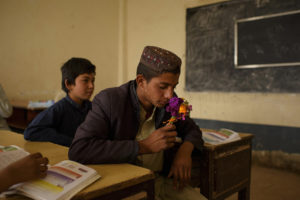
I find here, in Afghanistan, the picture itself is often subtler than its subtext, that is, what’s going on beyond the frame, what happened before and what will happen after it’s taken. In this case, what’s happening in this seemingly peaceful scene and what’s going on in the background are incongruous.
The village of Sayedabad, in Helmand’s Nadali district where this photo was taken, has an unusually high proportion of Hazaras for the south of the country. I was there with my colleague Sune Engel Rasmussen working on a story about an Afghanistan Local Police (ALP) commander, a Hazara, and his village that at the time was basically surrounded by Taleban-controlled villages. We spent a day and a night with him. We could see Taleban flags through a thicket of trees that provided cover for the villagers walking between their homes and the village centre. The ALP units scattered around the village were getting in firefights every day. Apart from the one road in and out, the village was more or less besieged.
Early on the second morning, the commander took us to the local school a couple of hundred metres from his house. When we arrived Afghanistan National Army (ANA) Humvees were parked outside the school and machine gun positions were on the roof, all while school was going on inside.
Children were arriving with small bouquets of flowers that they had picked on their way. Flowers are iconic in male Pashtun culture, and particularly in the south, you’ll often see young men and boys carrying them or wearing one behind an ear. These kids went one step further, though, bringing flowers to school and comparing their arrangements before the start of their classes. There were only four teachers for almost five times as many classes. The students told us that when there was fighting they hid under their desks.
Sune and I wanted to go back to Sayedabad to spend more time with the commander and at the school, but a couple of months later the village was overrun in a Taleban offensive that took the insurgents to the doorstep of the capital, Lashkar Gah. Most of those from Sayedabad fled. A few of the ALP commander’s men were killed. The government no longer has a presence there. The ALP commander is now in Kabul.
I find pictures like this one grow in significance when the place in which they were taken is no longer accessible. For me, they represent the ephemeral nature of any kind of stability in these rural areas.
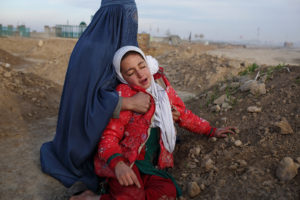
This picture was taken just over a month after Baynazar Mohammad Nazar was killed in the Médecins Sans Frontières (MSF) hospital in the US air strike in Kunduz city. (For a detailed account of this attack, see AAN’s Kate Clark dispatches here and here. See Andrew’s photographs from the destroyed MSF Kunduz Trauma Centre, published in Foreign Policy and for which he received a George Polk Award in 2016, here).
It took me a while to find Baynazar’s family. Initially, I spoke with his wife, Najiba, and his eldest son, Samiullah, over the phone, but I wanted to meet them if I could. As it happened they were also hoping to meet me. They had already seen the pictures I had taken of their father, dead on the operating table in the trauma centre. (A staff member from MSF in Kunduz who was helping me locate the family showed them before they were published.) It’s hard to imagine why, and I’ve never asked, but they wanted the pictures published.
I had four UN flights on four consecutive days cancelled on the runway in Kabul, and in the end decided to drive to Kunduz. Foreign Policy, who I had been on assignment for when I accessed the hospital in October, was eager to publish the story, and so, having already lost four days sitting in the UN passenger terminal in Kabul, I only had an afternoon and the following morning with them, during which time they told me what happened in the days before Baynazar’s death, as well as the days that followed, and some of their family history.
Before I left on the first evening, I asked Samiullah, the eldest son, if he could show me where his father was buried. The next morning, before my flight back to Kabul, we drove to collect him from an intersection not far from their place. (Visiting private homes in the back streets of Kunduz was still dicey, even after the Taleban had claimed to have withdrawn from the city – less for me than for the family members, who could be targeted if they were seen hosting a foreigner.) Samiullah was there along with the whole family, so we all piled into the car for the short drive to the cemetery, just five minutes from the centre of the city on an open hillside with a view over Chahardara district. We all got out and I followed them to the grave, leaving the fixer, Waqif, and driver, Safiullah, with the car.
Zahra was inconsolable. Samiullah was looking after his youngest brother, Khalid, who was six at the time, and seemingly unaware of what’s going on. When Zahra and her mother kneeled by the grave, it was probably more confronting, for me, than when I took the picture of their dead father and husband on the operating table in the ruins of the hospital. Photographing children in pain, I find, is the hardest thing to see. And it’s so intrusive to be that close in moments like this. I suppose I try to diminish myself – make myself small and quiet, take the minimum number of photographs necessary.
By special arrangement with AAN. Original link.



